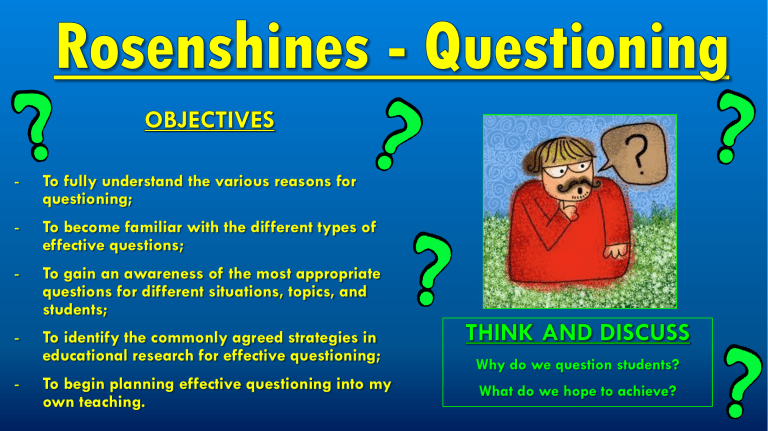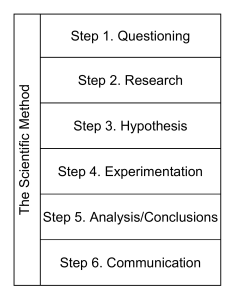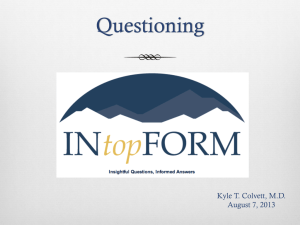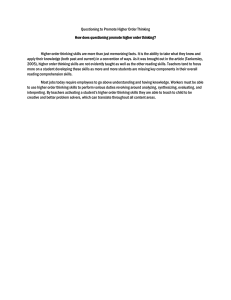
- To fully understand the various reasons for questioning; - To become familiar with the different types of effective questions; - To gain an awareness of the most appropriate questions for different situations, topics, and students; - To identify the commonly agreed strategies in educational research for effective questioning; - To begin planning effective questioning into my own teaching. Why do we question students? What do we hope to achieve? Ask Questions! One of the strongest implications from Rosenshines Principles of Instruction is that effective questioning lies at the heart of instructional teaching. Relevant instructional procedures include: • Ask a large number of questions and check for understanding. • Ask students to explain what they have learned. • Check the response of all students. • Provide systematic feedback and corrections. REASONS INCLUDE: - To formatively assess – to gauge what students know/ don’t know; - To drive learning forwards; - To promote engagement and positive behaviour; - To model curiosity/ encourage students to become questioners themselves; - To promote higher-order thinking and meta-cognition skills; - To break up teacher talk – questions allow for student input; - To offer model language or ways of thinking; - To challenge students and further extend their learning experiences; - To improve students’ speaking, listening, and collaboration skills. How do his questions influence the nature of the lesson and the reactions of his students? What does he do well? What does he not do so well? Click on the image for the hyperlink The teacher in the video used open questions to promote a deep level of thought and understanding. These type of questions are often referred to as higher cognitive questions. Look at the Bloom’s Taxonomy questions sheet. Discuss with your Conversely, more closed, factual based questions are known as lower cognitive partner and then feed back: questions. Which type of questions do you use most? Studies show that a combination of both types of questioning is more effective than an over-reliance on oneDo or the cognitive questions can be used to commit youother. haveLower an over-reliance upon factual knowledge toany memory, whilst higher questions can deepen and extend particular typeorder of questions? knowledge. What might be the effect of this? Bloom’s Taxonomy is the common method of ordering lower and higher cognitive questions, as is shown on the sheet that you have been given. -You will now be split into groups of between 4 and 6. -Of your group, one of you will be the teacher, one will be the observer, and the rest will be the students. -The teacher should select a topic card from their chosen subject, and aim to teach the rest of the class as much as possible about the subject in the time given. The aim is that all students learn something new about the topic. -They should begin by questioning the students about their prior knowledge, and move on from there. -The observer should aim to categorise the questions that the teacher asks, and note down the effect that each question has. -Rotate the different roles as often as possible in the time given. For the following task, you will need the Bloom’s Questioning Information Sheet, The Bloom’s Questioning Template Sheet, and the topic cards. Which type of questions did teachers mainly use? What was the effect of the lower cognitive questions used? What was the effect of the higher cognitive questions used? Which questions seemed to draw out the most information? How did teachers respond to insufficient answers? Who were the questions aimed at? What impact did this have? What would you change? Why? Wait Time -Whilst logic might suggest that a brisk pace is essential in order to maintain interest, research shows that wait time after questioning actually increases engagement; -Most studies on this area show that teachers do not wait long enough for a response after questioning – negatively affecting deeper thinking, especially for those who found topics difficult; -Stahl et al. (1994) discovered that the average teacher rarely waits longer than 1.5 seconds after asking a question, before intervening. -Budd Rowe (1972) advocates a wait time of at least 3 seconds for lower order questioning. -For higher order questioning, no threshold was observed. Students seemed to become more engaged the longer that a teacher waited. Think Pair Share Objective In pairs, you can give all students space to think, to air their initial thoughts, to confess their lack of knowledge and to prepare to give good answers, to rehearse. They are all involved and subsequent discussions then have lots of material to explore. It prevents ‘blood out of a stone’ silence inhibiting discussion and it prevents multiple students from raising their hands at once or shouting out. Practice Give the class a specific time-cued task, for example, to decide on four main points in order of importance, in three minutes. Get them all talking in pairs and then, on time, bring them back together with a signal. Then engage in probing answers from them. You can ask them to report back and share what their four points were. You can also get them to explain things to each other or to take turns to quiz each other based on prompt sheets or a text. Cold calling (TLAC by Lemov) Objective If we want all students to learn all the material then they should all be involved in engaging with the teacher-student dialogue with time to think, and not be allowed to hide, dominate or be overlooked. Practice No hands up! Teachers ask questions and then select students to respond based on their knowledge of the class, avoiding the pitfalls of hand-up or calling out. This is an inclusive process than conspicuously involves all of the students, front and back, in the corners, shy, confident – everyone. Its not a one off strategy, ideally it needs to be the default mode for questions – absolutely routine. https://www.youtube.com/watch?v=PARfIwF215k How many questions and when? -The British Council for Teaching English suggests that most teachers ask about 300-400 questions a day. -However, they implore that questioning should be measured on quality, not quantity. -They recommend following this checklist when planning questioning: 1. Decide on the purpose of the questions 2. Minimise the use of yes/no questions, except when checking meaning and understanding or encouraging weaker students 3. Ask a balance of higher and lower order questions, as appropriate 4. Personalise questions where possible, and make sure that they are clearly understood 5. Balance whole-class questions with student nominated questions 6. Give time for response, and plan for appropriate responses to questions. Feedback – Redirecting, Prompting, Responding -A teacher’s response to the feedback that a student gives is arguably as important as the original question itself. -Too often in lessons, teachers are too willing to merely accept or neglect insufficient or partial answers, in an attempt to hurry the lesson along. - Research has shown that vague feedback (such as ‘that’s not right, try again’) has no impact on student achievement, whereas further probing and redirection (e.g. ‘yes true, but how did you work that out?’) have a significant impact. -In your lesson planning, anticipate what the student responses (or partial student responses) may be. Think about how you might probe for further information, or redirect the student. -You are now going to be given the planning sheet on the left hand side -With your classroom assistant/ year or subject team, plan in some of the questions that you can use for an upcoming lesson. -Link them to Bloom’s Taxonomy – check that you have a wide enough variation, and begin to think of further probing and redirecting of student answers. - To fully understand the various reasons for questioning; - To become familiar with the different types of effective questions; - To gain an awareness of the most appropriate questions for different situations, topics, and students; - To identify the commonly agreed strategies in educational research for effective questioning; - To begin planning effective questioning into my own teaching. How did we do against our objectives? What will you take away from the session? Any areas that we need to revisit? Some Further Reading ‘Using Think Time and Wait Time Skillfully in the Classroom.’ by R.J Stahl, (1994) ‘Questioning Circles’ – Christenbury and Kelly, (1983) ‘Classroom Questioning’ – K. Cotton (1988)


